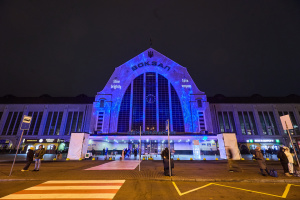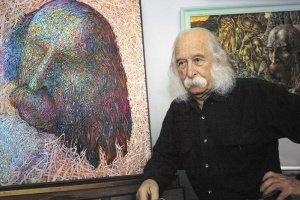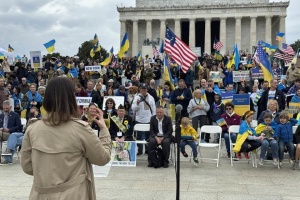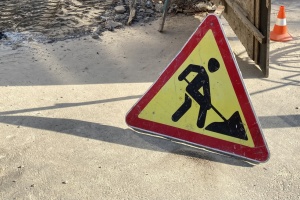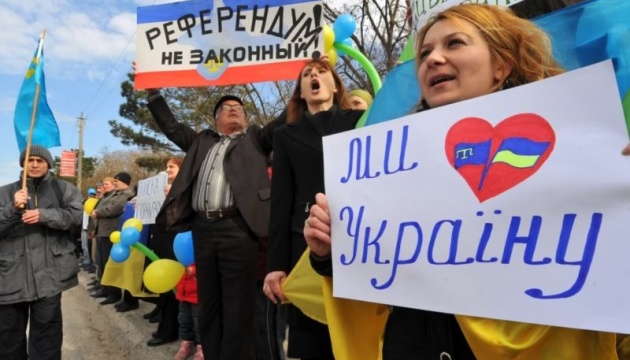
Falsified voices: Putin’s pseudo-referenda in Ukraine
The technologies used in the Autonomous Republic of Crimea and Sevastopol in March 2014 had already been tested earlier. In the early 1990s, similar votes took place, for example, in Transnistria, South Ossetia, and the Narva region of Estonia. This was not the first time for Crimea. Back then, Ukraine and Estonia managed to keep the regions in which the Kremlin desired to “protect the Russian speakers” in their constitutional field. And Moldova and Georgia were left with separatist enclaves, not controlled by the government, under de facto Russian occupation.
March 16 marks exactly nine years since the Crimean fake referendum. It was as illegal as the previous ones, but it had a key difference. Despite the fact that the “vote” of the 1990s raised the issue of not only “autonomy” or “sovereignty,” but also “independence” and even “reunification with Russia” of certain regions of these states, back then, the Kremlin did not dare to openly annex. The Crimean case became the first attempt in Europe in the 21st century to “legalize” the seizure of foreign territories under the guise of “expressing the will” of the local population.
There is a certain irony in the fact that the state which crushed the signs of democracy at home, where elections had not changed anything for a long time, and the dictatorial regime had not changed for almost a decade and a half (as of 2014), seemed to get interested in the opinion of the Ukrainians.
In 1938, a similar trick was performed by the Nazis during the Anschluss of Austria. This trick, obviously, inspired Putin and his accomplices to “new achievements,” the culmination of which was a full-scale invasion in 2022 and another attempt to annex Ukrainian territories.
Voting at gunpoint
The vote, which took place on March 16, 2014, was part of a special operation to occupy the peninsula. At that time, the Supreme Soviet of the ARC was controlled by the Russian military. They also organized a vote of MPs for the “referendum” and the appointment of the leader of the marginal party “Russian Unity” Sergey Aksyonov as the “head of government.” The Ukrainian military was blocked in military units. Activists for the unity of Ukraine were beaten, kidnapped, and tortured. Crimean law enforcement officers and officials massively took the side of the Russians. The latter, in turn, were clearly in a hurry with the “referendum.” Its date was rescheduled twice. Initially, they prepared the residents of the peninsula to vote for the fact that “the ARC has state independence and is part of Ukraine on the basis of treaties and agreements” (it was necessary to choose the options “In favor” or “Against”). The new wording of the questions was published only on March 6–10 days before the “vote.”
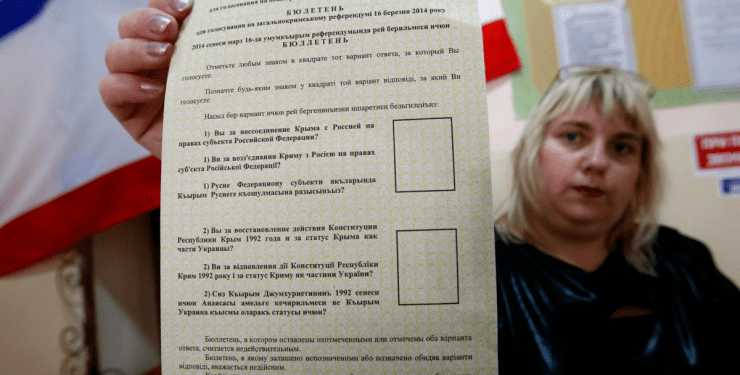
Source: Radio Liberty
Neither of the two questions to choose from provided for the preservation of the status quo: either undisguised separatism or the return of the separatist constitution of 1992, which established confederal relations between Kyiv and Simferopol.
On March 16, the course of the pseudo-referendum was “observed” only by unauthorized pro-Russian foreign freaks. None of the respected international organizations sanctified this lawlessness with the participation of its observers. But even without them, it was possible to observe the non-compliance with elementary standards. All those who wanted to vote did “vote” (even non-citizens of Ukraine) as many times as they liked. For themselves and for a friend. Under such conditions, there could be no question of recording the voter turnout.
The predicted positive “result of the expression of the will” was overwhelmingly high: 96% for the “reunification” of Crimea with Russia. Obviously, there was no counting.
Further events unfolded lightning-fast: already on March 17, Russia “recognized the independence” of Crimea and Sevastopol, and the next day, a theatrical action took place in the Kremlin with the signing of agreements on the inclusion of these Ukrainian regions in Russia, which were worthless from the perspective of international law.
The next step of the hybrid aggression against Ukraine was even more primitive pseudo-referenda in Donetsk and Luhansk oblasts on May 11. Emissaries of pro-Russian rebels drove around local communities with boxes and ballots. Back then, there was no clear front line in Donbas. Somewhere, the “referendum organizers” were allowed, somewhere they were kicked out; they did not reach a big number of settlements in the region at all. The propagandists assured residents that the proclamation of “independence” of the “LPR” and “DPR” will automatically lead to the cessation of hostilities and the return of peace to Donbas.
Back then, in Donetsk Oblast, the organizers of the “referendum” “reported” 89%, and in Luhansk Oblast — 96% of the support for “young republics.”
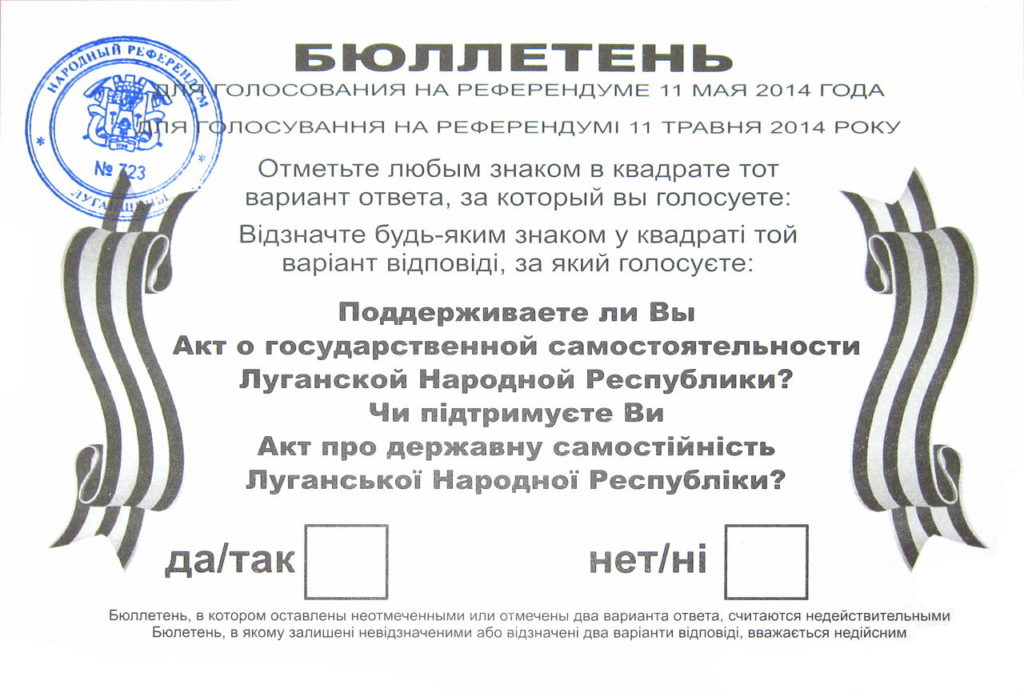
The Kremlin did not dare to annex the occupied areas of Donbas, despite the hope of the pro-Russian part of the local population. The region became a tool for destabilization of Ukraine, and its inhabitants — a resource for propaganda and reckless military plans of the Putin regime. Moscow prepared a similar role for the Crimeans.
Once again, it makes no sense to analyze violations of international law, national legislation, the principles of expression of will, and elementary arithmetic. Even then, it was obvious that the Kremlin was simply creating the necessary “picture.” It was supposed to prove to the world that Ukraine was a failed state, unable to ensure sovereignty on its own territories. But in 2014-2015, Ukraine withstood the blow, held parliamentary, presidential, and local elections, liberated a significant part of the occupied Donetsk and Luhansk oblasts and forced Russia to de-escalate the conflict.
And in 2022, not waiting for the “fulfillment of the SMO goals” or reaching the administrative borders of the occupied oblasts, the Kremlin decided to hastily “legalize” the loot and demonstrate some “great victory” to the Russians after the shameful escape from Kharkiv Oblast.
Pseudo-referenda in Zaporizhzhia, Kherson, Donetsk, and Luhansk oblasts were held on September 23-27.

The idea of holding a “fateful vote” in the midst of a full-scale war, when a significant part of locals fled from populated areas or got killed, seemed crazy to everyone, except for Putin’s clique.
The announced “results” sometimes outdid those of 2014: more than 99% in the “DPR,” more than 98% in the “LPR,” Zaporizhzhia Oblast — 93%, and Kherson Oblast — “humble” 87%.
The occupiers created the visibility of high turnout in various ways: by deploying “polling stations” on the streets and near the entrances of houses and going to each flat. In all cases, an additional argument to take part in the illegal voting was the presence of a number of armed Russian servicemen.
Photos and videos taken then in the occupied cities became a vivid visualization of the very “voting at gunpoint.” A significant role in the creation of the “picture” was given to polling stations in Russia and in occupied Crimea, allegedly open to Ukrainian refugees.
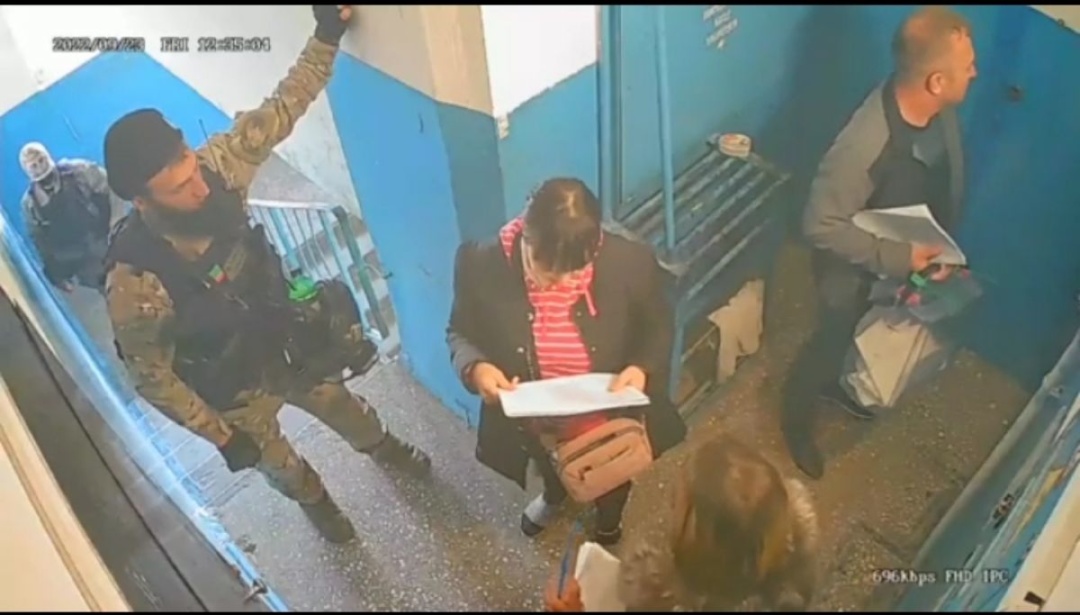
Despite the fantastic results, the Russians did not dare to outperform their Nazi predecessors, neither in 2014 nor in 2022.

As it turned out later, people in the occupied Melitopol and Horlivka “voted” for themselves and for residents, for example, of Zaporizhzhia and Kramatorsk, which the Russian invaders did not reach and, accordingly, no fake referenda were held there. Because Putin’s annexation, as was announced, concerns the regions within their administrative borders.
Russian myths about the Crimean pseudo-referendum
An important element of the information component of the special operation to occupy the Ukrainian peninsula was the public promotion of a number of myths that were supposed to justify the Russian crime, whitewash the reputation of the Kremlin, and discredit Ukraine. The Centre for Strategic Communication and Information Security reminds of the most common of them:
● Ukraine discriminated against the Russian-speaking population of Crimea and restricted the use of the Russian language. In fact, the Russian-speaking population had the most opportunities to meet their own cultural needs, compared to other groups of the population of Crimea. The Russian language dominated all spheres of public life on the peninsula: it was the working language of the Supreme Soviet of the ARC and other local authorities. Almost 90% of Crimean schoolchildren were educated in Russian (7% in Ukrainian and 3% in Crimean Tatar, respectively). Almost the entire system of higher education and preschool education in Crimea was also Russian-speaking. The vast majority of local media produced content in Russian. However, the Russian occupation regime has been severely discriminating against Ukrainians and Crimean Tatars for nine years.
● The referendum allowed the Crimeans to exercise their right to self-determination. In fact, the right to self-determination was exercised by the inhabitants of Crimea at the all-Ukrainian referendum of 1991, supporting the independence of Ukraine. After the “green men” seized the Verkhovna Rada of the ARC, there were no legitimate authorities on the peninsula that could announce and organize any voting. In addition, there was no legislative basis in Ukraine for holding local referenda, and, according to the Constitution, territorial issues should be resolved exclusively on an all-Ukrainian referendum.
● Russia “annexed” Crimea bloodlessly, “without a single shot.” In fact, the Russians repeatedly used weapons and violence against Ukrainian citizens during the occupation. On March 18, the occupiers shot warrant officer Serhii Kokurin, and on April 19 — major Stanislav Karachevskyi. The first confirmed civilian casualty of the occupiers was Reshat Ametov, who was kidnapped by the militants from the “self-defense of Crimea” in the center of Simferopol on March 3. After 12 days, his body was found with traces of torture. Kidnappings and repressions against Crimean Tatars and citizens loyal to Ukraine became commonplace on the occupied peninsula.
● Russia protected Crimea from the fate of Donbas, ensuring peace on the peninsula. In fact, the war in Donbas was a direct consequence of the occupation of the peninsula. Pro-Russian residents of the east of Ukraine were tempted by the promises of quick integration into Russia according to the “Crimean scenario” and allowed themselves to be dragged into another military reckless plan of the Kremlin. Crimea, like Donbas, was not threatened by anything within Ukraine, just like in all the previous years before the Russian invasion.
● The Crimeans did not resist the Russian occupation and massively supported the annexation. In fact, Ukrainian citizens held street rallies and supported the military in blocked units. The most massive was the rally organized by the Mejlis on February 26 near the building of the Verkhovna Rada of the ARC. It was then that an attempt to declare the “independence” of Crimea within the walls of the parliament was disrupted. The pseudo-referendum was held in conditions of armed aggression and occupation, so in no case can one trust its results.
What did the Crimean and other pseudo-referenda lead to?
Just as the Anschluss of Austria became a prologue to World War II, the attempted annexation of Crimea was the first page of the Russian-Ukrainian war that began in 2014. Having questioned the territorial integrity and sovereignty of Ukraine, the Kremlin defiantly began to destroy the international security system that had been formed after World War II. An attempt to forcefully redivide the borders led to the bloodiest war in Europe since Hitler and Stalin, the destruction of cities, the deaths of hundreds of thousands of people, millions were forced to leave their homes.
Taking credit for the protection of Crimeans from the ghostly war in 2014, eight years later, Putin brought them a real war. Today, Crimeans are dying in hostilities on the territory of Ukraine. The board of the scuttled cruiser “Moskva” included conscripted sailors from Crimea. Residents of the peninsula are illegally mobilized into the Russian army and used as cannon fodder, same as residents of other occupied oblasts of Ukraine. Similarly, the Austrians were forced to fight with the “enemies of the Reich” in the ranks of the Wehrmacht. As of the beginning of March 2023, volunteers of the “Information Resistance” identified 263 dead Crimeans. The full loss figures are much higher.
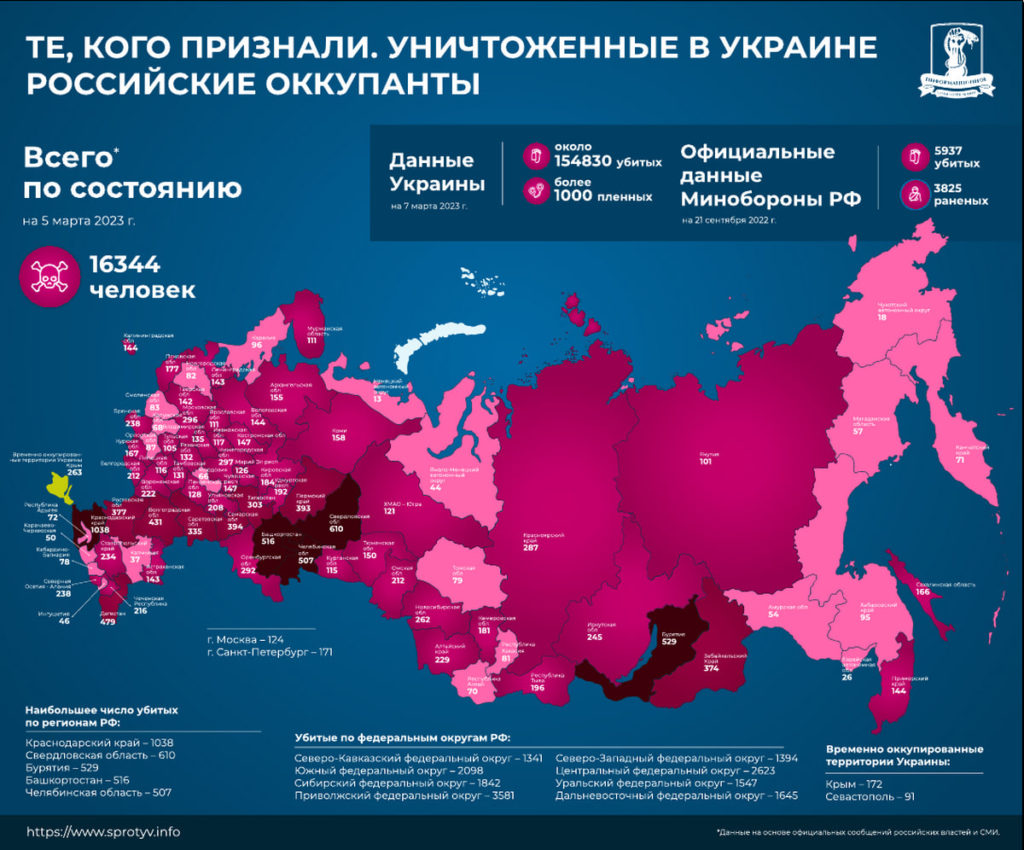
Source: Information Resistance
The liberation of Kherson in November 2022, which Russia had already declared its own a month before, actualized the issue of restoring Ukrainian sovereignty over Crimea, which had previously been de facto out of the question. Pseudo-referenda, which Russia used as a weapon, turned it into a state whose borders were no longer clear and internationally recognized. The restoration of the territorial integrity of Ukraine will call into question the territorial integrity of Russia. This is the main result of the reckless plan of the Putin regime in Ukraine.
Center for Strategic Communication and Information Security

